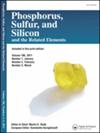Silicon nanoparticle(s) induced morpho-anatomical traits and improved micropropagation of white fleshed dragon fruit [Selenicereus undatus (Haworth)]
IF 1.4
4区 化学
Q4 CHEMISTRY, INORGANIC & NUCLEAR
Phosphorus, Sulfur, and Silicon and the Related Elements
Pub Date : 2024-09-02
DOI:10.1080/10426507.2024.2408774
引用次数: 0
Abstract
Silicon nanoparticles (SiNPs) improve plant growth and yield by enhancing nutrient uptake and stress tolerance. These nanoparticles boost plant defense mechanisms against pathogens and environmental challenges. In this study, seedlings-derived explants of white-fleshed dragon fruit (Selenicereus undatus) were used for differentiation and high-frequency shoot regeneration on Murashige and Skoog (MS) medium with 6-benzylaminopurine (BAP, 0.5 mg L−1) and α-naphthalene acetic acid (NAA, 0.25 mg L−1). The complementation of 3.0 mg L−1 SiNPs in the optimized nutrient medium enhanced the shoot multiplication rate to 23.0 cladodes per explants. The regenerated cladodes were structurally well-suited with thick cuticles, well-developed epidermis, hypodermis, aquiferous cortex, and collateral vascular bundles compared to the control and other concentrations of SiNPs tested. SiNPs promoted the development of 3-5 aerial and adventitious roots per cladode enabling preferred direct hardening of cloned plants on soilrite ex vitro. The morphological transformations improved by SiNPs, including the formation of robust cladode and spines, played a pivotal role in achieving a high rate of acclimatization success (96%) in the field. The incorporation of SiNPs in vitro at the shoot amplification stage of micropropagation of S. undatus induced morphogenesis and structural changes, and promoted qualitative and quantitative improvements in the regenerated cladodes which helped in enhanced survival of plants in vivo.
纳米硅诱导白肉火龙果形态解剖性状及微繁殖的研究[Selenicereus undatus (Haworth)]
硅纳米颗粒(SiNPs)通过提高养分吸收和抗逆性来促进植物生长和产量。这些纳米颗粒增强了植物对病原体和环境挑战的防御机制。以白肉火龙果(Selenicereus undatus)的苗源外植体为材料,在含有6-苄基氨基嘌氨酸(BAP, 0.5 mg L−1)和α-萘乙酸(NAA, 0.25 mg L−1)的Murashige和Skoog (MS)培养基上进行分化和高频芽再生。在优化的营养培养基中添加3.0 mg L−1 SiNPs可使芽增殖率达到23.0枝/外植体。与对照和其他浓度的SiNPs相比,再生枝在结构上具有较厚的角质层、发育良好的表皮、下皮层、含水皮层和侧支维管束。SiNPs促进了每枝枝3-5个气生根和不定根的发育,使克隆植株在离体土壤上更容易直接硬化。SiNPs改善的形态转化,包括强健枝和棘的形成,在田间取得高驯化成功率(96%)方面发挥了关键作用。在离体培养基中,SiNPs的掺入诱导了龙珠芽的形态发生和结构变化,促进了再生枝的定性和定量改善,从而提高了植株在体内的存活率。
本文章由计算机程序翻译,如有差异,请以英文原文为准。
求助全文
约1分钟内获得全文
求助全文
来源期刊
CiteScore
2.60
自引率
7.70%
发文量
103
审稿时长
2.1 months
期刊介绍:
Phosphorus, Sulfur, and Silicon and the Related Elements is a monthly publication intended to disseminate current trends and novel methods to those working in the broad and interdisciplinary field of heteroatom chemistry.

 求助内容:
求助内容: 应助结果提醒方式:
应助结果提醒方式:


